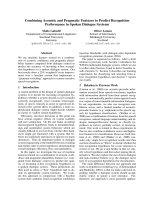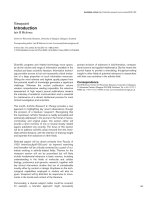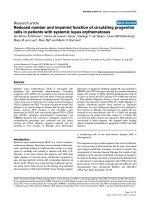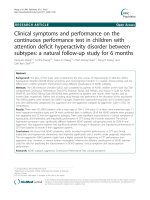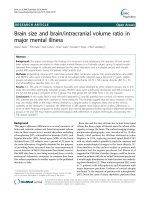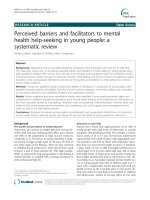Báo cáo y học: "Stroke volume and passive leg raising predict volume responsiveness in ICU patients: who is actually responsive" pps
Bạn đang xem bản rút gọn của tài liệu. Xem và tải ngay bản đầy đủ của tài liệu tại đây (36.2 KB, 1 trang )
Available online />Page 1 of 1
(page number not for citation purposes)
With much interest we read the article by Thiel and
coworkers [1], who clearly demonstrate how a completely
non-invasive technique can be used to determine changes in
cardiac stroke volume in response to a passive leg raise
maneuver (PLR) and actual fluid administration. Still, I have
some questions.
First, we wonder why the authors chose to enroll only the
patients who were a priori considered to require volume
expansion. Especially with the use of a non-invasive tech-
nique and the PLR being part of routine practice, it would be
very instructive to know which and how many patients from
the general ICU population are actually fluid responsive or
likely to be exposed to excess fluid administration.
Second, why did the authors perform the volume expansion
after the PLR with the patients again in the semi-recumbent
position? Patients are put in this position to mobilize more
volume for the actual PLR [2], but the stroke volume
response is studied in the supine position (which is also the
normal position for most ICU patients). Because of a
decreased preload it is very likely that more fluid has to be
administered to these patients to evoke a similar response in
stroke volume
Finally, did the authors anticipate this increased fluid
requirement when they administered a rather large volume
expansion (≥500 ml) in relation to the volume they estimated
to be mobilized with the PLR (150 to 200 ml)? Could it be
possible that these differences have influenced the sensitivity
and specificity of calculations?
Competing interests
The authors declare that they have no competing interests.
References
1. Thiel SW, Kollef MH, Isakow W: Non-invasive stroke volume
measurement and passive leg raising predict volume respon-
siveness in medical ICU patients: an observational cohort
study. Crit Care 2009, 13:R111.
2. Monnet X, Teboul J: Passive leg raising. Int Care Med 2008,
34:659-663.
Letter
Stroke volume and passive leg raising predict volume
responsiveness in ICU patients: who is actually responsive?
Jasper van Bommel and Eva Klijn
Department of Intensive Care, Erasmus Medical Center, 's Gravendijkwal 230 PO Box 3000 CA Rotterdam the Netherlands
Corresponding author: Jasper van Bommel,
Published: 30 October 2009 Critical Care 2009, 13:423 (doi:10.1186/cc8139)
This article is online at />© 2009 BioMed Central Ltd
See related research by Thiel et al., />
